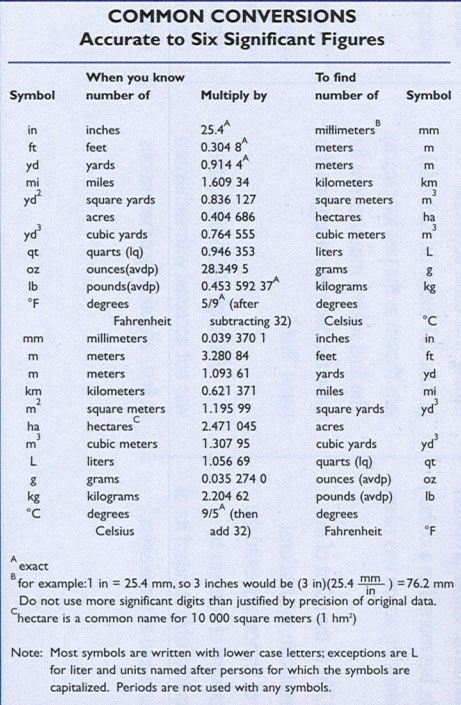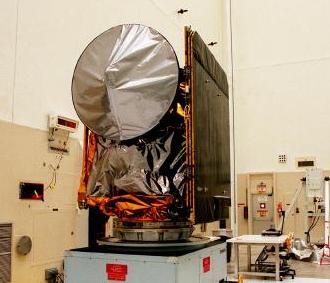This is "Unit 2", section 2.2 from the book General Chemistry (v. 1.0).
2.2 Metric-English Conversions
Learning Objectives
- To be able to convert metric measurements to English.
- To be able to convert English measurements to metric.
English-Metric Conversions
Through the centuries Americans have become familiar with an English system of units. So, as American chemists, we need to be able to convert between English and metric units.

Table of Conversion Factors Courtesy of the National Institute of Standards and Technology (NIST).
It is neither necessary nor desirable to memorize all of the factors in the above table. You will however need to know at least three factors from memory: one factor for mass, one factor for volume and one factor for length. One of each property is all that is required, assuming you know your metric prefixes from Table 1.4(2). Below are the three recommended metric-English conversion factors. Try to let these numbers make sense to you conceptually. For example, know that one-half kg is about 1 pound. Know that there are a couple cm or so in one inch and a L is a little more than a quart. The conceptual understanding makes it easier to memorize the factors.
454 g = 1 lb
1.06 qts = 1 L
2.54 cm = 1 inch
Figure 2.2(a)Mars Climate Orbiter

In the Spacecraft Assembly and Encapsulation Facility, workers prepare the Mars Climate Orbiter for a spin test. Photos taken on November 13, 1998. Targeted for launch aboard a Delta II rocket on Dec. 10, 1998, the orbiter was heading for Mars where it would primarily support its companion Mars Polar Lander spacecraft, which was planned for a future launch. The orbiter's instruments were to monitor the Martian atmosphere and image the planet's surface on a daily basis for 687 Earth days. The detailed images of the surface features could have provided important clues to the planet's early climate history and given scientists more information about possible liquid water reserves beneath the surface. The 327.6 million dollar spacecraft was lost in space on September 23, 1999 due to a conflict between English and metric units. Image Credit: By NASA/JPL [Public domain], via Wikimedia Commons
The examples below demonstrate how to use these factors. Hopefully you see the problem-solving process for the English-metric conversions is exactly the same as for the metric-metric conversions with the added spice of a few non-decimal factors.
One of the big advantages of using this conversion factor approach to problem solving is that you can easily look back at your work and see if you have made any mistakes. Just cross off your units and ask yourself if each factor is equal to the number 1. If the units and factors check out, your answer is correct, assuming your arithmetic is correct.
Note the Pattern
All conversion factors are equalities arranged in form such that the original units cancel.
Summary
Conversion factors are applied to change units from English to metric and from metric to English. To accomplish any conversion between English and metric from memory, one must memorize only three factors. One factor for mass, one factor for volume and one factor for length.
Key Takeaway
- When two measurements are directly related, for example, a measurement in cm and inches, one only needs to appropriately arrange a factor (numerator and denominator) such that the units cancel, to convert from one system to another.
Example 2.2-1
Courtesy of Fred Redmore, Highland Community College
-
Carry out the following conversions.
- 25.2 cm to in.
- 42.5 g to lb
- 2.4 in. to cm
- 82.5 qt to L
- 0.15 lb to g
- 6.50 in. to cm
- 8.50 lb to g
- 10.5 cm to in.
- 7.2 L to qt
- 67 g to lb
-
Carry out the following conversions.
- 85 cm to ft
- 0.245 qt to mL
- 3.2 kg to lb
- 67.5 in. to m
- 0.12 lb to μg
- 845 ft to km
- 6.2 lb to kg
- 0.452 m to in.
- 863 mg to lb
- 1.30 ft to cm
- 7.50 μL to qt
- 85.2 km to ft
Answers
-
(25.2 cm)= 9.92 in.
- (42.5 g)= 0.0936 lb
- (2.4 in)= 6.1 cm
- (82.5 qt)= 77.8 L
- (0.15 lb)= 68.1 g
- (6.50 inches)= 16.5 cm
- (8.50 lb)= 3.86 × 103 g
- (10.5 cm)= 4.13 in.
- (7.2 L)= 7.6 qt
- (67 g)= 0.15 lb
-
(85 cm)= 2.8 ft
- (0.245 qt)= 231 mL
- (3.2 kg)= 7.0 lb
- (67.5 in)= 1.71 m
- (0.12 lb)= 5.5 × 107 μg
- (845 ft)= 0.258 km
- (6.2 lb)= 2.8 kg
- (0.452 m)= 17.8 in.
- (863 mg)= 1.90 × 10-3 lb
- (1.3 ft)= 4.0 × 101 cm
- (7.5 μL)= 8.0 × 10-6 qt
- (85.2 km)= 2.80 × 105 ft





